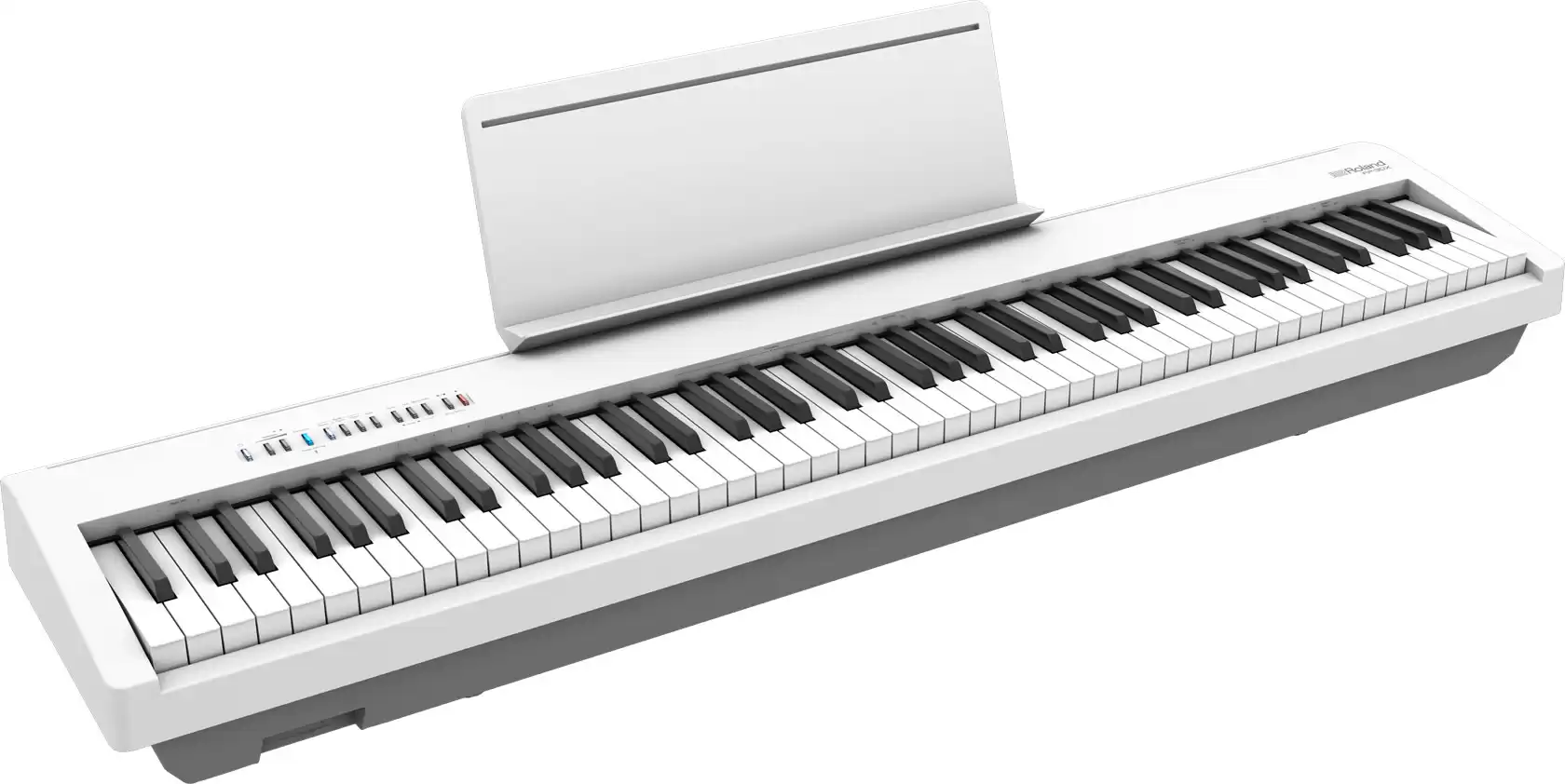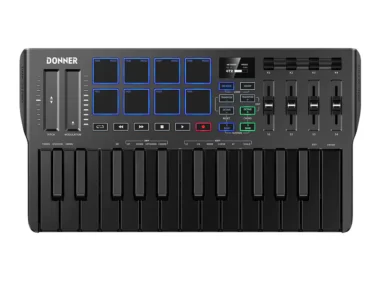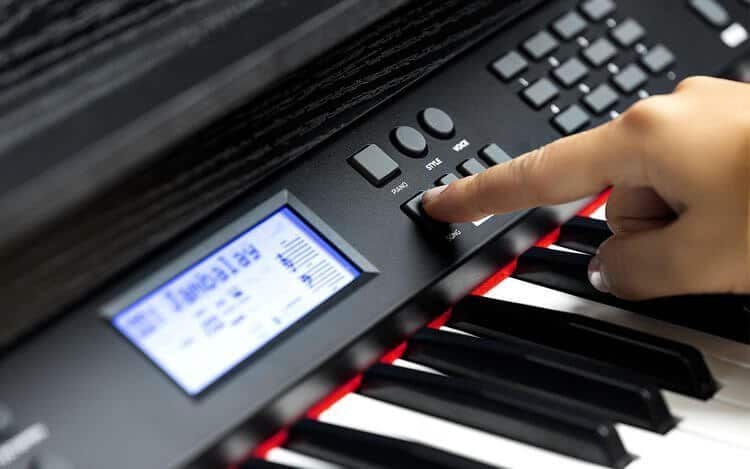*Keyboardkraze now has a nearly 24/7 chat service directly with me should you have any questions regarding keyboard/plugin choices! This is connected directly to me and it is not AI.
Table of Contents
The Roland FP-30X is the newest addition to the Roland FP-series. For the keyboard world, this is some pretty big news as this series was extremely popular last year for Roland.
One of the main questions that you’re probably wondering is, “is the FP-30X better than the FP 30?” I believe that it is definitely slightly better. We will be diving into the comparisons between the two later in this article, as well as breaking down what it does so well.
The FP-30X is the new improved version of one of my favorite mid-level digital pianos, the FP-30. Built with a solid key-bed and impressive piano sounds, the FP-30X provides pianists with everything they need for an affordable price.
It is important to note that Roland is still currently selling the FP-30 and at this point it is unclear for how long. The main thing to note here is that there is a $50 price difference between the FP-30 and the FP-30X.
Let’s get into the full review below.
Roland has managed to improve the FP series with an extremely powerful and innovative portable digital piano. The FP30X impresses right out of the box with its impressive key-bed and its sleek and slim design.
While the original FP30 was impressive, Roland has set out to make some improvements to give us all a look at a very professional digital piano near this price point.
Let’s take a quick look at the technical specs that make the FP30X impressive in our eyes.
Tech Specs Of The FP30X
- 88 fully weighted keys
- PHA-4 Stand keyboard-bed with escapement and Ivory touch
- Touch sensitivity, 5 types (fixed)
- Supernatural Piano Sound (Roland staple)
- Presets: 12 piano, 20 electric pianos, 24 other tones = 56 presets
- Polyphony: 256 note polyphony
- Effects Types: Rotary, ambiance, modulation
- Playback: 30 internal songs
- Metronome: Yes
- Audio Outputs: 2 x 1/4″ (L/Mono, R)
- Weight: 32.7 LBS with rest
- USB: 1 x Type B, 1 x Type A
- Bluetooth & USB
- Bluetooth: v3.0 (audio), v4.0 (MIDI)
- Headphones: Yes, 1 x 1/8″, 1 x 1/4″
- Power Source: AC Power adapter (Common)
- Speakers: 2 x 4.7″
- Amplifier: 2 x 11W
- Width: 51.1″
- Depth: 36.6″
- Colors: Available in black or white
Are you new to playing the piano? I just reviewed a great program called Pianote, and I highly recommend checking them out!
Design

The FP30X is available in both black or white with both versions being very sleek and slim to the eye.
Similar to the FP series, the FP-30X aims at delivering a portable and powerful digital piano that can fit in smaller spaces when needed.
When you compare this to the FP series, you will notice the specs are pretty close to identical as far as height and weight go.
As far as weight goes, the FP30X is slightly heavier than most of its competitors, but with this being said, it feels extremely durable.
The weight difference is not significant when compared to a couple of the other options near this price point and it is about one LB heavier than the FP30.
I personally think the FP30X has a very neat look to it, especially with the illuminated buttons. The layout is clean and everything is very easy to navigate.

As far as changing different settings, you will need to look at the manual as it does require you to hold down one button while navigating.
The lack of an interface is what leads to this, and if you compare it to its predecessor, it’s the same. It’s all very similar to any digital piano near its price point.
I’ve always preferred an interface with my keyboards, but in terms of slimming down the costs and providing a super-solid digital piano, I totally understand.
If you’re going to cut costs, you would rather not have to take away from something like the key-bed or speakers.
As far as the buttons go, they are sturdy and feel like they’re built to last.
Keyboard Bed
In terms of the key-bed, we are dealing with the PHA-4 from Roland, which is impressive. The keys are designed to feel like real ivory and they do a very good job at imitating this overall.
Note: PHA-4 stands for progressive hammer action. The way this works is that the key-bed has a different weight for each key ultimately giving the digital piano an incredibly realistic response to your fingers.
Down below, you will notice we compare the FP30X to the FP30 and you will find that the key-bed is the same on both models. With this being said, it’s a super impressive key-bed for this price point.
As far as touch sensitivity goes, you will notice that most digital pianos near this price only offer 3 different settings. The FP30X offers 5 different touch sensitivity settings to try and accommodate for all levels of pianists.
Speakers

The speakers on the FP30X are plenty to fill an entire room with a beautiful piano sound. You will notice that the FP30X is packed with 2 x 4.7″ built-in speakers with 2 x 11W amplifiers.
While these speakers aren’t as powerful as some of the keyboards at a higher price point, they do a great job for their price point.
These speakers are perfect for your house or apartment and they could even be used in a small coffeehouse.
If you’re playing for a considerable amount of people in a larger room, I would suggest running the FP30X through the PA or through an amp.
What makes these speakers so great for the price point is that the digital pianos from Casio, Yamaha, and Korg don’t matchup in this department.
This being said, while the speakers are quite powerful, they are facing downwards. I, personally think this is a little bizarre and would prefer them to upwards.
You may notice upon first playing that the sound might seem a little bit muted if you’re used to upward speakers. Have no fear, I adapted in about 15-20 minutes of playing and I couldn’t really tell the difference anymore.
Should you choose to want to mix it up, I always recommend a set of headphones for your keyboards. Not only are they great for when you’re wanting to keep the noise down, but they also can provide a different environment for practice.
Connectivity
The FP30X provides pianists with an easy way to connect via Bluetooth for audio and for MIDI. On top of this, you can also use a USB to connect.
For the audio outputs, we are looking at 2 x 1/4″ (L/Mono, R) and for USB you will need 1X type B and 1X type A.
As far as headphones go, we are looking at 1 x 1/8″, 1 x 1/4″ which is pretty nice for this price point. This means you could have dual headphones going at the same time, should you be practicing late night a friend or instructor.
One last thing to point out is that you have the option to upgrade to a 3-pedal unit should you want to spend the extra money.
I personally think the DP-10 which is included is more than enough and wouldn’t recommend upgrading.
Overall, the connectivity for the FP30X is far superior to anything near its price point and this is a big win for Roland. Having Bluetooth for audio and for MIDI is something I really like.
Accessories
The FP30X includes a Roland DP-10 damper pedal, which is a great sustain pedal we heavily recommend. This pedal retails for about $55, so this is a great deal to be included with the digital piano.
The FP30X includes the following accessories:
- Roland DP-10
- Music rest
- Ac adapter
- Owner’s manual
Software
Roland has included some additional software that includes “Piano Every Day,” and “Piano Designer.” These programs work with iOS and with android.
The FP30X is also fully compatible with GarageBand, should you have a macBook or iOS.
FP30X VS FP30
Let’s take a quick look at the differences between these two digital pianos. When it comes to the key-bed we are looking at the same one being the PHA-4. This is a solid key-bed, but it is the same for each digital piano.
Aesthetically, we are looking at a very similar digital piano in which not much has changed.
When it comes to polyphony, the FP30X outshines the FP30 giving you 256 note polyphony vs 128 note polyphony.
So, what does this mean? Having greater polyphony is important to a certain point. It is most important when it comes to layering sounds.
If you’re holding down 12 notes and each note has 4 layered sounds, you have to multiply to get to your polyphony.
This is the same for when you’re using your pedal. Generally speaking, 128 note polyphony is usually more than enough, and 256 is quite impressive.
Bluetooth Capabilities Of The FP-30X Are Superior
The FP30X has Bluetooth V 3.0 for audio and V 4.0 for MIDI. The FP-30 has V.40 for Bluetooth MIDI and I believe it is very similar to the FP-30X in this department.
This is actually a great advancement for digital pianos near this price point.
As far as the speakers go, you will find identical speakers and amplifiers on the the FP30X and the FP30.
To sum up the main differences between the FP-30X and the FP30, the FP-30X has greater polyphony, more presets, and more Bluetooth capabilities. It also weighs in at about a LB more than the FP-30, however, you won’t really be able to tell this difference.
Lastly, the FP30X has a built-in mic input, whereas the FP30 does not.
The FP30X has recently secured a spot on our best Bluetooth digital pianos list and I recommend checking that list out.
FP-30X VS Yamaha P-125

As far as the key-action goes, the FP-30X takes it home. If you’re familiar with my reviews, I almost always pick the digital piano that just plays most like an acoustic piano.
When we break it down spec-wise like below, we will also see the FP-30X takes it home overall as well.
The Yamaha P-125 lacks Bluetooth capabilities, which for some is a big deal. I am personally a huge supporter of everything Bluetooth for digital pianos. Roland has Bluetooth dialed in for the FP-30X, making it the winner here.
Wrapping Up
The Roland FP30X adds to an already impressive FP30 design & build, overall resulting in a state of the art portable option near its price point.










22 comments
There were some issues with the FP-30 with the headphone output, resulting in very soft and not so good sound on a lot of headphones, Do you know whether that issue has now been solved?
Hey Erik, I’m not positive on if this has been resolved as I really wasn’t too aware of the FP-30 problem.
I would guess that if this was a major complaint, Roland would’ve fixed this issue. Another thing I would bring up is that because of the popularity of the FP-series, it would be in Roland’s best interest to fix this issue with the FP-X series.
Hope this helps,
Chris
I purchased the FP30X and my only complaint is the volume on the headphones are low with the RH5 headset; I have the volume on the highest setting. I tried some other headphones (MPOW) and there is considerable improvement with the volume.
Great review Chris
I have the FP30 and use it for Bluetooth MIDI, so not sure the Bluetooth upgrade.
I had the audio and Bluetooth mixed up for some reason in my blueprint!
Thanks for the note, Greg!
Cheers
FP30 didn’t have bluetooth audio, now avail in the 30x
I think the FP-30 didn’t have Audio Outputs: 2 x 1/4″ (L/Mono, R) like in the FP-30X. If this is the case, this is the most important improvement, specially if you want to use it also for gigs (not only at home).
You are right!
Thanks for the comment and reading this!
Could you tell how noisy are the keys of FP-30X while playing compared to other pianos? I used to have Roland HP302 where thumping was really audible, even outside the room, even when playing softly. I ignored reviewers’ warning about that and then regretted it 🙂 I heard FP-30 has annoying clicking which develops over time but this should not be a problem for me (I hope), as I intend to mainly use headphones while playing. I just want other people outside my room not to hear me playing, often late at night.
DP-2 pedal is included; DP-10 is a seperate buy as far as Roland states in the specs.
1.. Does “Bluetooth Audio” mean wireless headphones would work with the FP-30X? Or is that something else?
2. Does the Roland app include the same lessons (for beginners) and the same supplementary sounds/voices on all your digital keyboards (e.g., FP-10, FP-30, FP-30X), or is the material that I have access to depend on the model I purchase?
Thanks.
1. I believe “Bluetooth Audio” is referring to recording audio directly to a DAW wirelessly, so as to not require an audio interface. Though I’d be interested to have that confirmed by someone who has used this feature!
I’ve used this feature, and that’s correct!
Cheers
Hello, are you absolutely certain that the FP30X has a mic input? I have checked the Roland specification sheet.
Looked at the image of the back of the keyboard, I can’t see the connection point. I believe it is available for the 60 and 90 in the series. It is shown as available on the RD88.
Hi Ed,
According to Sweetwaters specification page, I’m seeing mic input. Before purchasing, you could verify with their sales team, as I was unaware that mic input wasn’t on the specifications page of Roland.
Chris
I’m a bit surprised that you don’t mention the huge sound improvement of the e-pianos…
That’s really night and day! For example, what was supposed to sound like a Rhodes (one of the Rhodes, should I say) was really ugly/terrible/atrocious/unplayable on the FP-30! As demonstrated by ThePianoForever on YT (“Hype or Truth? – Roland FP-30″ Full review” at 18:25), this “Rhodes” on the FP-30 has 4 to 6 different tones/voicings, which makes you feel like you’re playing on different instruments from one half-step or octave to another. I thought my FP-10 was defective until I watched his video… Hard to believe that Roland released such a shxxy tone and nobody except this guy mentions it in the reviews. Well… I know… And you know…. Anyway… sent back an FP-10 with the exact same issue (of course) and bought an FP-30x instead. Less than 200 bucks well spent!
I have had the FP30 for four years now.
It is definitely the nicest digital piano I have ever owned!
The BlueTooth Control from my tablet makes it very easy to switch between the many sounds and effects the Fp30 has to offer.
The downward facing speakers give a very real acoustic sound to the FP30.
Otra diferencia que al menos yo encontre con el fp 30 que este ultimo tiene ritmos grabables y el 30 x no los tiene, cuando pones el ritmo de la aplicación no lo graba, solo sale el sonido piano u otro instrumento
I now have both the FP-30 and the FP-30X at home and I can say that the newer one is a huge disappointment for me. Yes, it has more polyphony, plays music over BT and has a few extra sounds, but…
When switching the sound, the original one is briefly interrupted and then fades away, but with a different character, probably some kind of sound effect of new sound
Absolutely senselessly graded mix balance with dual tone. You want to make the strings a bit stronger than the piano, but next to the middle position, there is one where the strings totally drow out the piano – this corresponds to the extreme position of the FP-30, and at the next position, the piano becomes even more still
The volumes of individual sounds are very different, what is annoying
As for the new sounds – some of them seem like caricatures of the original ones on the FP-30, some are completely missing
It must also say that when playing through the piano’s speakers, the sound was “tuned” for higher volume, but at the cost of suppressing low frequencies, which further degrades the instrument
To be fair – the new sounds are nice and if I were just using the piano the difference between the instruments is negligible and the FP-30 only has one usable church organ, the 30X has three..
I’m used to roland putting out perfectly tuned stuff but this is just a work in progress and no matter what anyone says, I’m FP-30. It is a very solid, consistent and well thought out instrument
Hey Tom!
Thanks for the note. My biggest hangup is what you stated first with the original tone getting interrupted. I’ve been noticing volume difference between patches in a few other keyboards lately as well.
Kind regards,
Chris
Hi Chris,
for me personally it means the end of roland. Professional honor would never allow me to let something like that out. And the same problem is with the FP-E50, which I returned for this. In addition, the E50 still flickers the controls, maybe at a higher frequency like 100Hz, but I perceive it, just like with led bulbs. And for people who don’t perceive it, it’s just as harmful. It is simply an economic solution completely unworthy of Roland. It makes me sad, but the way I drive old cars, use old hi-fi, old cameras, so I’ll just keep using the FP-30 until I die 🙂 I’m actually surprised that this trend has reached Roland only now, when in in all sectors since the turn of the millennium.
I have really expected the 30X to have a few extras over the 30, but not that they’re going to totally screw up something so perfect.
For me, it’s something like the difference between the old honest Nokia 3310 and the new one, which is actually no longer Nokia at all.